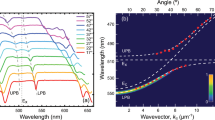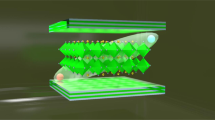Abstract
The optical properties of organic semiconductors are almost exclusively described using the Frenkel exciton picture1. In this description, the strong Coulombic interaction between an excited electron and the charged vacancy it leaves behind (a hole) is automatically taken into account. If, in an optical microcavity, the exciton–photon interaction is strong compared to the excitonic and photonic decay rates, a second quasiparticle, the microcavity polariton, must be introduced to properly account for this coupling2. Coherent, laser-like emission from polaritons has been predicted to occur when the ground-state occupancy of polaritons 〈ngs〉, reaches 1 (ref. 3). This process, known as polariton lasing, can occur at thresholds much lower than required for conventional lasing. Polaritons in organic semiconductors are highly stable at room temperature, but to our knowledge, there has as yet been no report of nonlinear emission from these structures. Here, we demonstrate polariton lasing at room temperature in an organic microcavity composed of a melt-grown anthracene single crystal sandwiched between two dielectric mirrors.
This is a preview of subscription content, access via your institution
Access options
Subscribe to this journal
Receive 12 print issues and online access
$209.00 per year
only $17.42 per issue
Buy this article
- Purchase on Springer Link
- Instant access to full article PDF
Prices may be subject to local taxes which are calculated during checkout





Similar content being viewed by others
References
Pope, M., Swenberg, C. E. & Pope, M. Electronic Processes in Organic Crystals and Polymers 2nd edn (Oxford Univ. Press, 1999).
Lidzey, D. G. et al. Strong exciton–photon coupling in an organic semiconductor microcavity. Nature 395, 53–55 (1998).
Imamoglu, A., Ram, R. J., Pau, S. & Yamamoto, Y. Nonequilibrium condensates and lasers without inversion: exciton–polariton lasers. Phys. Rev. A 53, 4250–4253 (1996).
Kasprzak, J. et al. Bose–Einstein condensation of exciton polaritons. Nature 443, 409–414 (2006).
Deng, H., Weihs, G., Snoke, D., Bloch, J. & Yamamoto, Y. Polariton lasing vs. photon lasing in a semiconductor microcavity. Proc. Natl Acad. Sci. USA 100, 15318–15323 (2003).
Christopoulos, S. et al. Room-temperature polariton lasing in semiconductor microcavities. Phys. Rev. Lett. 98, 126405 (2007).
Malpuech, G., Kavokin, A. & Laussy, F. P. Polariton Bose condensation in microcavities. Phys. Status Solidi A 195, 568–578 (2003).
Malpuech, G., Rubo, Y. G., Laussy, F. P., Bigenwald, P. & Kavokin, A. V. Polariton laser: thermodynamics and quantum kinetic theory. Semicond. Sci. Technol. 18, S395–S404 (2003).
Giebink, N. C. & Forrest, S. R. Temporal response of optically pumped organic semiconductor lasers and its implication for reaching threshold under electrical excitation. Phys. Rev. B 79, 073302 (2009).
Kena-Cohen, S., Davanço, M. & Forrest, S. R. Strong exciton–photon coupling in an organic single crystal microcavity. Phys. Rev. Lett. 101, 116401 (2008).
Davydov, A. S. Theory of Molecular Excitons (Plenum Press, 1971).
Zoubi, H. & La Rocca, G. C. Microscopic theory of anisotropic organic cavity exciton polaritons. Phys. Rev. B 71, 235316 (2005).
Litinskaya, M., Reineker, P. & Agranovich, V. M. Exciton–polaritons in a crystalline anisotropic organic microcavity. Phys. Status Solidi A 201, 646–654 (2004).
Kena-Cohen, S. & Forrest, S. R. Giant Davydov splitting of the lower polariton branch in a polycrystalline tetracene microcavity. Phys. Rev. B 77, 073205 (2008).
Kena-Cohen, S., Davanco, M. & Forrest, S. R. Resonant Rayleigh scattering from an anisotropic organic single-crystal microcavity. Phys. Rev. B 78, 153102 (2008).
Debernardi, P., Bava, G. P., Degen, C., Fischer, I. & Elsasser, W. Influence of anisotropies on transverse modes in oxide-confined VCSELs. IEEE J. Quantum Electron. 38, 73–84 (2002).
Litinskaya, M., Reineker, P. & Agranovich, V. M. Fast polariton relaxation in strongly coupled organic microcavities. J. Lumin. 110, 364–372 (2004).
Mazza, L., Fontanesi, L. & La Rocca, G. C. Organic-based microcavities with vibronic progressions: photoluminescence. Phys. Rev. B 80, 235314 (2009).
Tassone, F. & Yamamoto, Y. Exciton–exciton scattering dynamics in a semiconductor microcavity and stimulated scattering into polaritons. Phys. Rev. B 59, 10830–10842 (1999).
Avanesyan, O. S. et al. Features of light-emission and stimulated Raman-scattering in anthracene-crystals. Soviet J. Quantum Electron. 7, 403–405 (1977).
Litinskaya, M. Exciton polariton kinematic interaction in crystalline organic microcavities. Phys. Rev. B 77, 155325 (2008).
Tischler, J. R., Bradley, M. S., Bulovic, V., Song, J. H. & Nurmikko, A. Strong coupling in a microcavity LED. Phys. Rev. Lett. 95, 036401 (2005).
Acknowledgements
The authors acknowledge fruitful discussions with H. Deng. This work was performed at the Lurie Nanofabrication Facility at the University of Michigan and was supported by Universal Display Corp. and the Air Force Office of Scientific Research.
Author information
Authors and Affiliations
Contributions
S.K.C. and S.R.F conceived the experiments. S.K.C. fabricated the structures and carried out the measurements. Both authors contributed to the analysis and manuscript.
Corresponding author
Supplementary information
Rights and permissions
About this article
Cite this article
Kéna-Cohen, S., Forrest, S. Room-temperature polariton lasing in an organic single-crystal microcavity. Nature Photon 4, 371–375 (2010). https://doi.org/10.1038/nphoton.2010.86
Received:
Accepted:
Published:
Issue Date:
DOI: https://doi.org/10.1038/nphoton.2010.86
This article is cited by
-
Observation of transition from superfluorescence to polariton condensation in CsPbBr3 quantum dots film
Light: Science & Applications (2024)
-
Plasmon mediated coherent population oscillations in molecular aggregates
Nature Communications (2023)
-
Uncovering temperature-dependent exciton-polariton relaxation mechanisms in hybrid organic-inorganic perovskites
Nature Communications (2023)
-
Polarization superposition of room-temperature polariton condensation
Communications Materials (2023)
-
Exciton polariton interactions in Van der Waals superlattices at room temperature
Nature Communications (2023)



